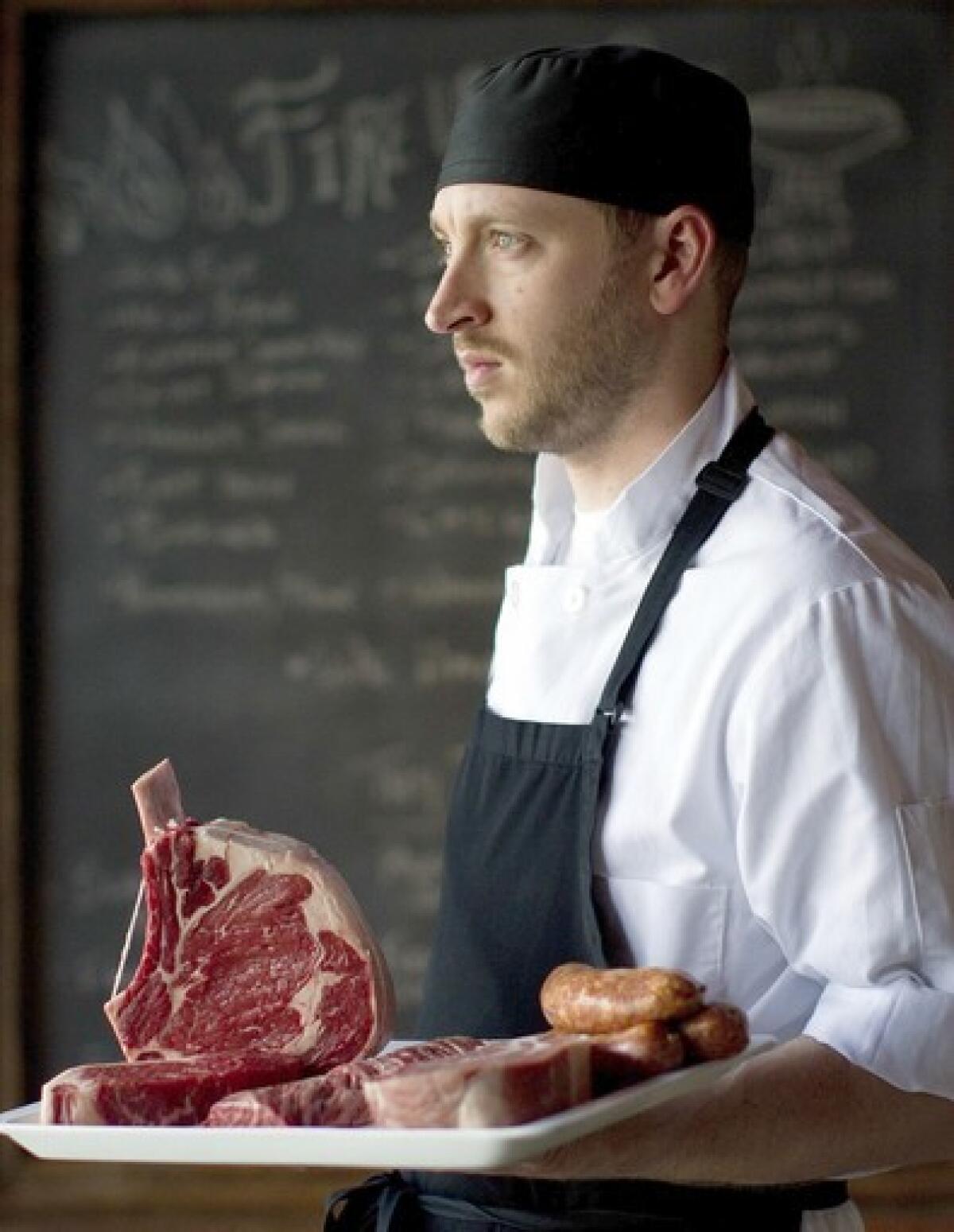California Cook: The return of the butcher

- Share via
The butcher is back.
After decades of laboring in obscurity, seeing their craft slip away to the point it was practically extinct, butchers — real meat cutters, not guys who repackage steaks from Cryovac bags — are regaining their respected place in the food chain.
You can see it in the crowds at Lindy & Grundy on Fairfax Avenue and at McCall’s Meat & Fish Co. in Los Feliz, where customers line up outside when word comes in that a whole pig has been delivered.
Southern California meat market standbys, including the Huntington Meats and Marconda’s Meats in the original Farmers Market, high-end supermarket chains Bristol Farms, Gelson’s and Whole Foods, are seeing business pick up.
There’s even a MEAT club at UCLA — the Meat Education and Appreciation Team — that sponsors meat cooking events, including trips to butcher shops for private lessons. And in the last few months, at least six popular books on butchery have been published, with such beguiling titles as “The Art of Beef Cutting” and “Whole Beast Butchery.”
To think that just a few years ago, the butcher was practically an endangered species.
“People are seeking the truth now,” says Amelia Posada, who runs Lindy & Grundy with her partner, Erika Nakamura. “Consumers across the country are trying to understand what is going on out there in the food world. They want to know where their food is coming from and how it was raised. They like the idea of clean food and buying from someone they trust. This was such a creepy industry for so long.”
Posada and Nakamura are the most hard-core of L.A.’s new-wave butchers. They source most of their meat from individual ranches and work from primal cuts — beef quarters from Rancho San Julian in Lompoc, whole pigs from ReRide Ranch in Lake Hughes and lambs from Stemple Creek Ranch in Santa Rosa.
But even the butchers that don’t go to those lengths are finding customers who appreciate a more hands-on approach. At Nathan McCall’s tiny storefront on Hillhurst Avenue, which he opened almost 21/2 years ago with his wife, Karen Yoo, there simply isn’t enough room to work regularly with whole animals, though he does get in pigs from ReRide Ranch occasionally — to much demand.
He says the draw at McCall’s is service. At most supermarkets, the folks selling you meat rarely do more than repackage already prepared cuts onto Styrofoam trays. At a real butcher shop, you can not only get meat cut to your liking, you can get cooking advice as well.
McCall and his wife are both former chefs, and most of their employees are former restaurant workers. The same is true at Lindy & Grundy.
“A lot of our business is based on interaction with customers,” McCall says. “I know guys who are great butchers, but when they cook at home, they basically just throw a steak on the grill. We have a lot of customers who have questions about how to cook things, and that’s part of the service we provide. We want to give them the confidence to cook the things they buy from us. We want to make it easy for them. And if they have trouble when they’re cooking? Give us a call.”
Indeed, it’s not easy even finding skilled butchers these days. So great was the trade’s fall from grace that most of the infrastructure for training them has vanished. At many markets, the apprenticeship programs that once provided most of the preparation have fallen by the wayside.
Pete Davis, the senior meat manager at the Bristol Farms chain, a butcher for almost 50 years, says even he has trouble finding trained meat cutters.
“It’s hard to sustain the talent levels that we need,” he says. “It’s not anything that someone can’t learn. It just takes time. But for us to pick up a chain store guy and work with him, to get it to the point where he fits our program takes a good solid year. And that’s an experienced, good worker.”
Customers need training too. Particularly with items such as grass-fed beef, supply can be very seasonal. And when a store is trying to source meat more directly, that means every cut isn’t going to be available all the time. There are only so many rib-eyes on any given steer.
Still, there’s little question the public is responding.
“The past six months we’ve been going crazy,” says Posada of year-old Lindy & Grundy. “We have people crowding in just to look at what we have. We give tours of our walk-in! Certainly it’s part of the whole food-as-entertainment thing, but it’s got to be more than that. We have people coming in from as far away as Simi Valley and San Diego. Saturdays here are like Disneyland.”
More to Read
Eat your way across L.A.
Get our weekly Tasting Notes newsletter for reviews, news and more.
You may occasionally receive promotional content from the Los Angeles Times.











